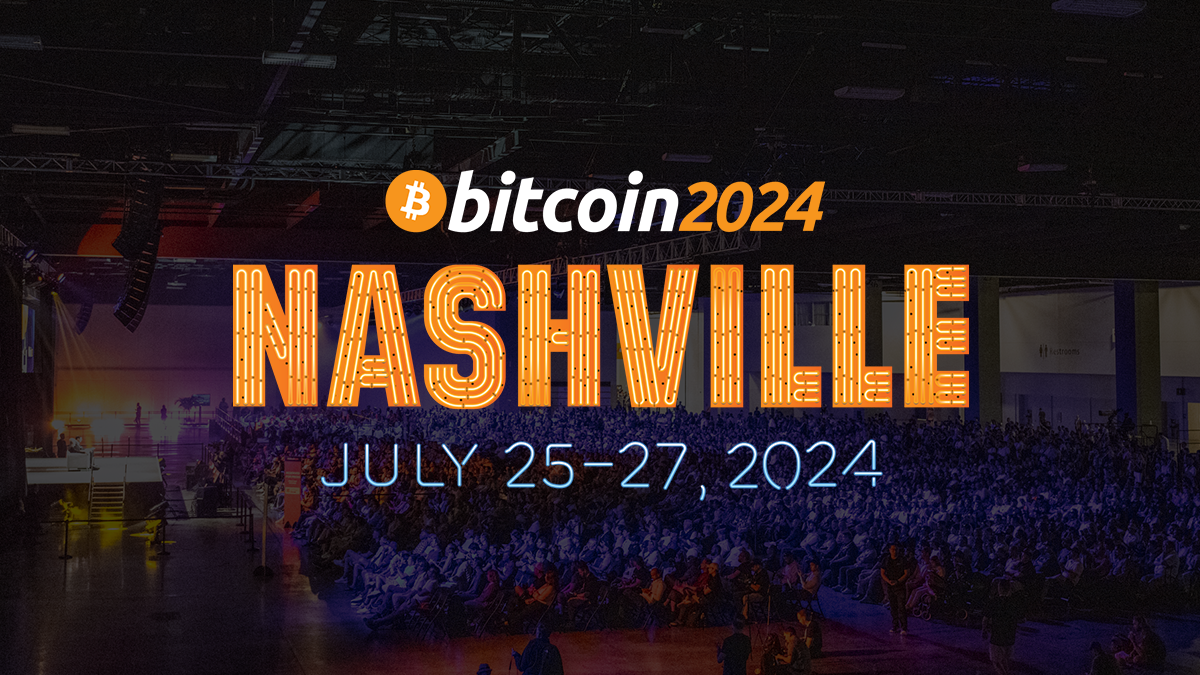Month: July 2024
UK building firms face worst recruitment problems, survey shows
Post Content
Bitcoin 2024 to Host ‘Bitcoin Propaganda Track’ In $5,000 Winner Take All Challenge
Bitcoin 2024, the world’s largest Bitcoin conference, will feature a new creative contest at this year’s event, designed to mobilize and inspire broader audiences about Bitcoin: The Bitcoin Propaganda Track.
The Bitcoin Propaganda Track calls on content creators to submit original videos and memes that uniquely showcase Bitcoin and the potential impact of this revolutionary technology, offering a $5,000 prize in BTC to the winner.
The contest, part of the Official Bitcoin Games 2024 Hackathon, invites participants to produce commercials, memes, or any form of engaging content that crafts compelling narratives around Bitcoin. Interested participants are asked to create 30-60 second commercials showcasing Bitcoin, as well as memes that effectively communicate key Bitcoin concepts and data.
Submissions must be made here (or emailed to michael.markle@btcmedia.org with the subject line including “Hackathon Submission [Project Title].”) by July 17th at 11:59 PM ET. The winner will be announced on stage during the conference and featured in Bitcoin Magazine.
The judges for the contest are Mike Germano, President of BTC Inc. and Bitcoin Magazine, Brandon Green, BTC Inc.’s Chief of Staff, TIP_NZ, a Bitcoin advocate known for her artistic contributions through rap and visual storytelling, and Hills, a notable member of the Bitcoin Puppets community.
For further details and guidelines, visit the virtual hackathon’s website and join the hackathon Discord channel located on the site.
Update: ALL #Bitcoin 2024 Hackathon tracks have had their deadlines extended!
Submit by Wednesday July 17 for a chance at over $65,000 in prizes – paid in #BTC!
Join here: https://t.co/p9nnD0xQII pic.twitter.com/fi1SZqJMbJ
— The Bitcoin Conference (@TheBitcoinConf) July 15, 2024
Bitcoin Magazine is owned by BTC Inc, which also owns and operates the world’s largest Bitcoin conference, The Bitcoin Conference.
Dollar lower after Powell, crypto climbs as investors eye Trump win
Post Content
Reflections on Bitcoin Culture
I admit I’m nostalgic for Noam Chomsky. Chomsky is a controversial figure, but he’s also a hero for his writings on consent and conformity, and he was perhaps the most articulate in calling out the development of the deep state. Now 95 years old, he had a massive stroke last year and can no longer speak. This article isn’t really about him, but it is inspired by him. Bitcoin is an electronic peer-to-peer cash system that is working, but the world we’ve built around it is incredibly alienated and disconnected from the rest of society. We’ve been effectively siloed, and anyone who thinks this will help adoption is dreaming. I think the room stinks and that this little Bitcoin world isn’t working for Bitcoin.
The irony about the people who like Bitcoin, and I mean really like Bitcoin—the kind of people who would read this article—is that they, or we, think they are immune to propaganda. They believe they are immune to the processes that manufacture consent for decisions that are not their own, and which, given a chance to consider independently, they would not condone.
Bad news. You are not immune. In fact, I think many of the people who call themselves “bitcoiners” today are only “bitcoiners” because they were propagandized into it. An entire cultural reproductive machine is being built around Bitcoin, and it is incredibly reactionary and, in many ways, bigoted.
For example, posting an LGBTQ flag with the Bitcoin symbol on it is beyond controversial. Attacks on people who are trans or queer and who contribute far more than 90 percent of the people who hold Bitcoin is normalized. Abusive behavior against women is normalized.
This cultural reproductive machine comes in the form of popular influencers who are often millennial men spending a lot of time taking photos of themselves flexing their muscles in front of a mirror. I really wonder how big those muscles have to get to protect the fragile ego buried beneath those muscular fibers.
These influencers are not selling anything real. They are not selling you a way out of the existing system. All they are doing is giving you a simple narrative that will help you sleep better at night. You’ll be okay, just remember: all the bad things happening are because “money printer go brr” and transgender ideology.
I call it a cultural reproductive machine because I’m seeing a lot more people holding the same narrow-minded, ignorant, and bigoted ideas taking up space. These ideas are spreading and poisoning well-meaning people’s minds. I wonder if those who hold these ideas could just stop for a moment and ask themselves, “Where did these ideas come from? When did I start believing this?” Realize that the narratives around you are often built so that you think you invented them yourself.
If you’re new to Bitcoin, keep in mind that you don’t have to conform to the mainstream ideas. You don’t have to be for the orange man who likes the orange coin (claims to, anyway). You don’t have to eat steaks every day and hate seed oils. You don’t have to believe in a transgender ideology or hate queer people. You don’t have to keep an altar in your garage where you pray to Hayek every night for the day the collectivists are finally wiped clean from this planet.
The reality is that Bitcoin is for anyone who needs it. Bitcoin is apolitical money. Bitcoin doesn’t need a political party, and Bitcoin doesn’t need states. The only thing that Bitcoin needs is people to use Bitcoin and learn about how it works.
Noam Chomsky made some really good points about the problems with society that I think are still relevant. American democracy is alienating because it’s not really a democracy. He said that when political systems function without public input, the general population feels marginalized. It’s obvious that many of you are here because you feel marginalized by this corporate-run society. It’s normal to react. But don’t let people with a loud mouthpiece try to convince you to act against your best interests. Bitcoin wins when we accept each other as we are. Bitcoin wins when we maintain healthy skepticism of political leaders and their promises. Bitcoin wins when we organize against the powers that are trying to destroy us.
I’m sure I’ve triggered plenty of you, but then again, that’s the whole point of this stream-of-consciousness rant. I want you to be triggered. I want others who don’t agree with you to realize that they aren’t alone. No matter how suffocating the bigotry and fascist tendencies may be right now in this space, there are still many of us who will not consent.
You’re not alone.
This is a guest post by Margot Paez. Opinions expressed are entirely their own and do not necessarily reflect those of BTC Inc or Bitcoin Magazine.
Bitcoin Price Breaks $63,000 Following Assassination Attempt on Trump
The price of Bitcoin surged past $63,000 after an assassination attempt on former U.S. President Donald Trump during a campaign rally.
Bitcoin jumped nearly 10% from below $58,000 on Friday to over $63,000 on Monday morning. The sharp move higher came after a gunman opened fire at a Trump rally in Pennsylvania on Saturday.
While Trump survived with minor injuries, analysts linked the rising price of Bitcoin to improved odds of a Trump election victory in November. Trump has embraced Bitcoin and crypto and pledged to roll back regulation, making him the preferred candidate for many Bitcoin advocates.
Moreover, Doland Trump Team has also confirmed that he will still attend the Bitcoin 2024 conference in person in Nashville in two weeks. This further validates his commitment towards the Bitcoin.
Exchanges saw heavy trading volume as bitcoin broke above its 200-day moving average. Some analysts view sustaining this technical level as a bullish signal after weeks of downward pressure.
The gains add to Bitcoin’s recovery from lows near $53,000 earlier this month when sell-offs from the Mt. Gox payouts and the German government spooked markets. Traders are hoping this bounce marks a definitive bottom.
Bitcoin is regaining its footing above $60,000 after a brutal few weeks. If the breakout rally continues, Bitcoin may yet return to all-time highs in anticipation of a Trump presidency.
Dollar steadies ahead of Powell’s speech; euro edges higher
Post Content
Dollar strengthens after Trump shooting; Asia FX weakens
Post Content
Running the Gauntlet
This article is featured in Bitcoin Magazine’s “The Halving Issue”. Click here to get your Annual Bitcoin Magazine Subscription.
Halvings are always looked at as seminal events, a demarking of the end of one era and the beginning of a new one. In the same way that Americans come out of the woodwork to clamor over the new set of presidential candidates in the election cycle, Bitcoiners come flooding out to celebrate the successes of the past block reward epoch and look forward to the possible successes of the next.
I would argue that this halving, it is imperative to do the exact opposite of that in regards to the mining ecosystem. We should be deeply concerned with the potential of what can go very wrong in this next epoch, and how parts of the mining ecosystem can fail in ways that present a systemic risk to the Bitcoin ecosystem.
Bitcoin post ETF approval is finally lunging forward in terms of developing integrations with the legacy financial system, and while this is definitely something that will contribute to deeper market liquidity and likely positive price movement, it is also something that will come with the heavy cost of providing fuel and food to an external influence on Bitcoin that will need to be resisted and fought every step of the way in order to maintain the important characteristics of Bitcoin. Decentralization, censorship resistance, the ability to offer people a truly sovereign money that is within their control.
The integration of bitcoin backed products into the legacy financial system is going to draw the scrutiny of regulators and legislators like we have never seen before. The floodgates are now open in terms of people being able to freely allocate their funds to bitcoin exposure (I say this specifically because they have only price exposure and not ownership). This presents the potential for a massive migration of funds from other asset classes into bitcoin, which would have serious implications for the performance of those other asset classes depending on the size of that reallocation.
This is exactly the type of situation in which the government typically makes significant regulatory changes in reaction to a fundamental change to the structure of market dynamics. Regulators are going to come for every layer of the mining stack, as that is what the rest of the network and protocol is dependent on.
Click the image above to subscribe!
Mining Pools
Mining pools are the lowest hanging fruit for regulators to go after. Pools are an economically necessary aspect of the mining industry. Without pools, two things would be wildly different for everyone mining.
First, any miner not of sufficient size would have highly irregular income. Without pools to well, pool miners’ resources together and proportionately share the income from the block reward regardless of who actually found the block, miners’ income would be highly unpredictable and a stretch of bad luck in not finding blocks could literally bankrupt an operation. Without this added predictability to income, the mining ecosystem would be a very different landscape with a radically different risk profile for participants. Second, in a world of nothing but solo miners, there would practically speaking be a minimum percent of the network hashrate any given miner would need to make up in order to have any chance of running a viable business. If you are 1% of the network, you have decent odds of hitting at least a block or two a day. If your percentage of network hashrate drops much smaller than that, the irregularity of payouts can get drastic. With energy bills to pay at the end of every billing cycle, that is not a tenable situation for miners. A utility company won’t care that you “just had an unlucky month.”
Where Does The Money Go?
Miners pooling resources for more predictable payouts, for better or worse, is an ingrained part of the ecosystem that operations depend on in order to run a predictable business. This means that as long as they exist, centralized mining pools will present an easy low hanging target for government regulators. Mining pools are inescapably custodians, whenever a miner in a pool finds a block the coinbase reward does not pay out to that miner (with some recent exceptions such as Ocean), it pays those bitcoin out to the mining pool. This pool custodies funds on behalf of the actual miners until they choose to withdraw. Regulators worldwide require compliance for businesses that custody funds on behalf of other people, they simply haven’t caught up to the reality that is a critical function of mining pools. This is in fact exactly why Ocean launched with a model paying out their miners directly in the coinbase reward, so they could function in a way that does not involve custodying of other peoples’ funds.
It is inevitable that pools begin getting overt pressure from regulators to comply with requirements of custodial entities. The only option at that point will be for pools to comply, or attempt to replicate the model Ocean is operating with in order to remove the need for compliance. This comes with its own challenges, namely scalability. As I said earlier in regards to a world where only solo mining was possible, that would create a minimum viable size for a mining operation just in terms of regularity of payout in order to pay the bills. A naive on-chain only payout system directly in the coinbase transaction creates similar issues. Miners must have a certain minimum size or they will not earn a large enough proportional share of a block reward to make economic sense to pay out directly on-chain.
That scalability issue of miner payouts needs to be solved or we find ourselves in a world where we still run into possibly troublesome limitations if we manage to escape regulatory influence at this level. There are a few possible paths that could be taken to address this issue. Braidpool attempts to solve it by using large Schnorr multisig addresses requiring a majority of miners to sign off on properly distributing the rewards. CTV offers two ways it could assist, from just committing to eventual payouts to individual miners that could be cut through optimistically with multisig, or enable coordination free mining pooling through a scheme originally proposed by Jeremy Rubin. Jeremy’s scheme essentially looks backwards at past blocks within some threshold of being recent, and when you find a block shares the reward with the coinbase address of those past blocks. If any of those miners doesn’t share theirs accordingly when they find their next block, you stop sharing with them. The idea is to reconstruct the benefits of a conventional pool purely through incentives that mutually benefit all involved while requiring no central coordination.
Regardless of how it actually is solved, it is a problem that needs solving. Without a solution, a core part of the mining ecosystem is inevitably going to be subjected to a large swath of regulations. Major mining pools like Antpool and Foundry – almost 50% of the network mines with them – already require KYC procedures to be followed to mine with their pool. As long as custodying of funds is involved in pool operations, this is likely to become a legally mandated requirement in the near future.
Who Let That Get In There?
One of the core functions of miners in general is processing transactions in blocks, this is how the network is able to function as a payments system. Miners, or rather these days mining pools, construct the actual block template and decide which transactions to include in the block they are currently working on. This puts mining pools in a precarious position as far as regulations are concerned with processing financial transactions.
There are arguments on both sides as far as liability is concerned with what transactions miners do or do not include in their blocks, but it is a fact that the government is putting their attention on exactly that question of liability. Carole House, former director of cybersecurity and secure digital innovation at the White House, recently brought up exactly the question of miners’ liability to abide by the OFAC Sanction’s list at a House Financial Service Committee hearing in February.
In addressing the committee she argued specifically that the question of criminal activity occurring on the Bitcoin network can be addressed at the protocol level rather than simply applying regulations and enforcement actions solely at the level of custodial businesses. Her argument was that miners have an existing obligation under current regulations and laws to exclude transactions to or from OFAC sanctioned addresses in their block templates.
This argument is going to be made much more heavy handedly, and the reality is that this is going to be a very tough fight to avoid. Mining pools, and individual miners, factually have the ability to decide whether or not to include a transaction in their block. This is inarguably true. If this ability is legally interpreted as being a party to or facilitator of a transaction, then they do have the legal obligation to exclude any transactions involving OFAC sanctioned addresses from their blocks.
The only arguments that can be made against this either essentially fall under arguments that propagating Bitcoin related information is free speech, or that the requirements to comply with these regulations create an undue economic burden on miners. I am not a lawyer, but something tells me the latter argument of “we can’t make enough money to be profitable without accepting transaction fees from criminals and terrorists” would not be viewed favorably by a court, even in a world where those transactions constituted such a large percent of miners potential revenue that it would be a serious consideration. That leaves the free speech argument.
Mining pools would have to essentially make the argument that they are an “interactive computer service” under Section 230. Section 230 was designed to provide a liability exemption for platform operators functioning on the internet, due to the practical concerns of them being able to properly moderate or remove illegal content consistently due to the nature of how these platforms work. It specifically exempts platform operators and other users from any legal liability that could result from the actions of another user of the platform.
In order to actually make this argument and have it stand, it would have to be successfully argued in court that a bitcoin transaction itself is simply speech. That is a very tall order, and I say that as someone who thinks there is a very solid case to be made there. The argument would have to be made that whenever someone is using Bitcoin directly at the protocol level, i.e. crafting and broadcasting their own bitcoin transactions instead of using a custodian, that their engagement with the network and protocol is an exercise of free speech.
If this argument cannot be successfully made, then Bitcoin’s censorship resistance ultimately depends on less than 51% of the hashrate being subjected to a jurisdiction’s regulations requiring such censorship be undertaken by the miners themselves. The United States currently hosts close to 40% of the hashrate in the world, with almost 30% being hosted in the state of Texas alone. If that share of hashrate in the United States grew to exceed 51%, it would enable American miners subject to such restrictions to enforce that globally by orphaning blocks from foreign miners that included sanctioned transactions.
Dealing with this issue either depends on mining remaining competitive and distributed enough that no one jurisdiction ever exceeds that danger threshold, or successfully making and winning the case that Bitcoin transactions are an exercise of free speech. The only alternative to those two options is to outright resist and hope that a jurisdiction with such a hashrate majority is incapable of enforcing censorship requirements. And that is not even considering the potential for multiple jurisdictions cooperating to enforce such requirements in coordination with each other.
Hashrate On The Ground
Mining pools present a low hanging fruit to go after in terms of regulatory compliance and enforcement, but ultimately the thing underlying that is the actual hardware operators on the ground. Any regulatory action taken against pools isn’t going to end there, the express purpose of it in the first place is to go after the actual hardware owner operators. Mining pools are simply a convenient first step along that road with a relatively low cost for compelled compliance and enforcement actions.
Public Company Shackles
Public mining companies have proliferated this last cycle wildly. This has opened a massive can of worms in terms of systemic risks and problems. First and foremost, these mining operations are now accountable to their investors with the potential for legal avenues to override operational decisions under the auspices of shareholders interest. On its own this isn’t inherently bad, it’s in fact a potential mechanism ensuring their prioritizing of profit maximization, which is an absolute necessity in a cut through competitive industry such as Bitcoin; but this dynamic exists in an environment where they are held to much higher scrutiny from regulators.
By virtue of being publicly traded, a public company is allowed little if any ambiguity, they have no real privacy in internal operations, anything material about the business must ultimately be made public for existing and prospective investors.
One such example is SOX Compliance requirements. These are reporting and audit requirements established under the Sarbanes-Oxley Act in 2002 in direct response to major accounting fraud scandals at the time such as Enron and WorldCom. The Act placed a much heavier burden on public companies, and delineated specific separation of concerns between the internal company accounting process and the auditing process, which is now legally required to meet specific standards of independence from the company in question. It also requires more in depth financial disclosures, including assets off the company balance sheet and corporate officers’ stock transactions.
All of these public companies and their information are right in the open for instant compliance verification and enforcement in the event of new regulatory requirements. Nothing is ambiguous, nothing is unknown or uncertain, there is no camouflage or possibility of flying under the radar. The legal structures involved in a publicly traded company making non-compliance not an option.
Information Collection
The government is looking to collect any information they can get their hands on regarding actual mining operations. This is indisputably demonstrated by the recently attempted Department of Energy EIA Emergency Survey that was rescinded after a court case in Waco, Texas brought against the EIA by Riot Platforms and the Texas Blockchain Council. That was assuredly not the end of the matter. They want information on privately owned operations as much as public companies where it is already easily accessible.
The EIA demanded information on every commercial mining facility in the United States. They wanted GPS coordinates, the available power in their purchasing agreement with utilities, the utility company they bought power from, the amount of power actually drawn, and the amount of hashrate they had. This trend is not going to stop here. The larger this network grows in economic terms, the more politically relevant it becomes. The more politically relevant it becomes, the more regulations politicians will want to pass. Regulations require information and deliberation.
Even without specific surveys targeted at collecting information directly from miners, agencies have an amazing set of data sitting there waiting at utility companies for them. Energy providers learn quite a lot about consumers of large amounts of power just in the course of making purchase agreements with them. In the event courts or legal processes do not allow them to demand information directly from miners, especially privately owned ones, there are paths to acquiring this information indirectly.
In the most extreme cases, it is possible to actively probe for information. Multiple methods have been developed in the last few years to analyze data around electrical pull from end consumers on the grid. Some use deep learning, others analyze the actual modulation of the electrical current. These methods can be used to detect the presence of Bitcoin miners by analyzing power flow upstream from them on the grid. In the absolute worst case scenario, governments will easily be able to detect any mining operation connected to the power grid by looking at net amounts of energy consumption or the modulation of the actual current itself by the grid connected consumer. If the NSA can establish surveillance closets with Internet Service Providers in the normal course of operations, why not power companies as well?
On a physical level, things are going to go heavily in the favor of governments and regulators. As long as you are connected to the grid, there will be no escaping them.
Off The Grid
Getting off the grid is the only even remote hope of staying off the government’s radar as a miner. Without the connection to the grid, there is no real time electrical feed to analyze, not as invasive if any data collection as a necessary byproduct of having a purchase agreement with a utility company. It’s the only place any meaningful privacy or stealth can be achieved.
Off grid energy is not easy to come by at scale though. Anyone can install a solar panel on their roof, but that doesn’t output much energy measured in terms of hashrate. It might power a handful of machines, but even with large numbers of people engaging in such small scale operations it won’t in aggregate be able to compete with larger scale operations. If you hunt around you might be able to find some decommissioned hydroelectric power stations somewhere, but that requires a lot of capital if even allowed legally, and is not something you can accomplish without getting yourself on the radar.
Natural gas wells are the only real possibility of scaling an off-grid operation. I say possibility because it is not a guaranteed path to mining off the government’s radar. Oil and gas wells are still subject to regulations and data collection on their own, but the relative distribution of mineral rights offers the possibility of creating many more degrees of separation between regulators and the actual mining operator. There are people all over with a well on their property who will just sell you the gas without the invasive collection of information required on the grid. You might even find some abandoned and capped wells out there if you know where to look.
But even this is a game of cat and mouse. Gas flare mining isn’t some tightly kept secret, everyone knows it occurs. That information is out there and collectible if governments decide to put in the effort and resources to collect it. In the most extreme scenario, numerous governments worldwide have satellites that track methane emissions from well sites and general areas all over the world. For everything that miners can do to stay under the radar, if governments want to spend the resources they can find them anyway.
Ultimately this aspect of the equation, the physical hardware on the ground, will likely never be able to escape regulatory ire to any sizable extent. This problem ultimately can’t be solved with technology. It comes down to successful legal challenges of regulations, without which miners will be subject to the regulations of their host jurisdictions. If miners do not arbitrage this risk by spreading themselves diversely across many jurisdictions that do not cooperate with each other, then this represents a systemic threat to the whole system.
Who Brought The Chips?
Mining has two absolute requirements as a business, two things that an operation definitively cannot exist without: energy and mining hardware. You can’t have mining hardware without ASIC chips. Energy is an abundantly distributed resource, available all over the planet from numerous diverse sources. ASIC chips are not so distributed. There are only a handful of places in the world that they can be sourced, with even fewer places they can be produced, and ultimately dependent on an even more centralized supply chain root.
ASICs do not grow on trees, and the production process is not likely to become any more distributed than it is right now any time in the near future.
Economic Centralization
When it comes to asic manufacturers, there’s only really a handful of competitive ones. Bitmain, MicroBT, Canaan, and Innosilicon. There are other companies, but they are a tiny sliver of the marketplace and mostly small Chinese companies. These are essentially your options if you want to get your hands on mining hardware to start an operation.
The market for chips is one of the most centralized, if not the most centralized aspect of the mining ecosystem. It gets even worse when it comes to the actual production process. TSMC in Taiwan is pretty much the cutting edge of chip fabrication in the world. They are always the first to market with the latest nm production technology, and function as the backbone of global semiconductor manufacturing at the bleeding edge. BITMAIN is the only Bitcoin mining company they will do business with. There is currently no possibility for other manufacturers to make use of TSMC production capabilities.
That essentially means that Intel in the US and Samsung in South Korea are the only options at scale for ASIC production. No other major companies can service an ASIC manufacturer at scale. This is an ultimate chokepoint at the very root of the mining industry that is as heavily centralized as it can possibly be. It’s essentially in practice a duopoly, with Intel as of now giving up on ASIC production after their first attempt at a manufacturing run did not live up to their expectations in terms of performance. You have TSMC, monopolized by BITMAIN, and then Samsung.
The economics of semiconductor manufacturing require a massive capital investment, billions of dollars, to construct a new production facility. They are not something you can just spin up overnight, and not something anyone can just jump into the market for and start competing. The barriers to entry are massive, in terms of economic cost as well as technical specialization. This issue, much like the ability to hide an operation from the government, is something that in the end is inescapable.
Politics, Leverage, and Arrakis
The industry gets even worse when you appreciate the degree of centralization at the very root of the manufacturing process: the production of the machines that produce the chips. For this part of the supply chain there is only one game in town, ASML Holding in the Netherlands. They are the only manufacturer world wide that can provide the machinery to produce cutting edge semiconductors at the bleeding edge of nm width.
This gets very political very quickly at this point. Under the pressure of the US, ASML does not export certain equipment to mainland China because semiconductor production technology is treated as a national security issue. The United States spent billions of dollars under the Trump administration to incentivize TSMC to build a manufacturing facility in Arizona in the US, specifically because of the massive supply shocks to the semiconductor industry during 2020 in the midst of coronavirus lockdowns.
It is not outside the realm of possibility, maybe even inevitable, that such geopolitical treatment of the semiconductor industry in general becomes a norm tailored more narrowly on the production or sale of Bitcoin mining equipment specifically. If bitcoin does what we think it could optimistically do this decade in terms of price appreciation, if it does actually grow to the point of becoming a factor in the macroeconomic picture that cannot be ignored, then the production, sale, and operation of mining equipment is going to become a national security priority for every nation in the world.
All we can really do, unless you have tens of billions of dollars sitting around to throw at building a chip manufacturing facility, after somehow getting the necessary machinery sourced from ASML with a multi-year lead time, in a jurisdiction where the government cannot interfere with your ability to produce and export mining machines, is hope that the incentive balance of geopolitical dynamics far beyond Bitcoin itself in scope play out in a way that leads to sufficient distribution of that manufacturing capacity.
In the novel Dune, spice was the center of the universe. It was the thing without which interstellar travel was impossible. Spice was harvested on the planet Arrakis, and whoever controlled the spice controlled the human race. Taiwan is our Arakkis, and semiconductors are our spice. Since the computer was invented it has integrated deeper and deeper into the foundations of human society, to the point that nothing can function without them. It is a geopolitical issue as important as oil.
Bitcoin is on a crash course to insert itself right into the heart of that geopolitical element.
Time For The Kick In The Head
Bitcoin doesn’t exist in a vacuum. It isn’t some academic thought experiment, or a computer simulation where the variables directing the outcome can be fine tuned exactly how we want them to be with trivial effort. It exists in the real world, with real people, and the realities that result from real people interacting with each other.
Everyone is caught up in celebration and staring at the market price increasing because of the ETF approvals, patting themselves on the back that we’ve won. It’s all over, there’s nothing left to do but kick back and enjoy the predetermined outcome where we become fabulously wealthy and the entire world bends to Bitcoin’s will.
That’s not how this works.
Bitcoin exists in this world, as something operating within human society. In the form of mining, it has an actual physical footprint in the real world that it is dependent upon, without which it cannot exist or function. That physical infrastructure must be defended. It must be distributed and redundant enough that attacks on parts of it cannot disrupt the whole.
Government has funded itself and exists because of their control and monopoly over the ability to print money. Without deficit spending it could never have grown to the insane size it is today, it would never have attained the power and influence to interfere in all of our lives to the degree it does today. With that power being distributed all over the world, to anywhere there is energy and ASICs available, do you think they will do nothing?
Knowing there is a physical component that the entire network is dependent on the function, do you think they will not attack it? Try to capture it? We are just now entering the phase of “then they fight us.” This is not going to be a walk in the park, and it’s not something that this ecosystem should get complacent about.
We get one chance to run the gauntlet, and if we fuck it up, we fuck it up.
This article is featured in Bitcoin Magazine’s “The Halving Issue”. Click here to get your Annual Bitcoin Magazine Subscription.
Bitcoin Personas: How Coinbits Approaches Crafting User Experience
Introduction
At Coinbits, we’re dedicated to improving the UX of bitcoin so that more people can benefit from it. In our ongoing commitment to transparency and community engagement, we recently made our product roadmap public. Now, we’re excited to share another work product which was made as a part of a Summer of Bitcoin project: Bitcoin Personas.
Persona pitfalls
Coinbits is a family-run bitcoin-only exchange. We are a small startup with a big vision – to build the first #HybridBanking platform that seamlessly combines bitcoin and fiat financial services.
Our team is mostly made up of engineers, but several of us also have a background in product and design. We recently decided to revamp our user personas in order to strengthen our foundation for continued product-market fit.
Personas are fictional descriptions of target users and are used to focus development teams on the human needs of the people for whom they build products. Although they have been a mainstay of UX and innovation teams for decades, in recent years, personas have developed a reputation of being a high-investment project with questionable ROI. This is largely because they tend to be underutilized by the audience for whom they are created – internal engineers, designers, and executives.
Too often, beautifully-designed personas are created by a UX team, presented in a meeting, and promptly forgotten. And even if they aren’t, do they really provide product insights, or are they too fictional, fluffy, and final?
When personas fail, it is likely that one or more of these reasons is the culprit:
They try to be too broad and inclusive instead of specific and exclusive.They don’t tell a character-driven story; they do not feel like real people.They go big on superfluous details.There are too many of them so they become hard to keep in mind during the product development process.
A better approach
We believe that the best way to approach personas is to think of them as summaries of user research in which the whole development team participated. In other words, engineers, executives, and designers really should have been present during a substantial portion of the user interviews. If a UX team goes off to do research and comes back with a deliverable, the rest of the team will have missed out on the opportunity to build direct, empathetic bonds with the real people who use the company’s products.
Instead, consider the work product to be the interview itself, and conceive of the personas as more akin to documentation of that work product.
Ideally, to run a persona project, a UX owner plays the role of servant leader of a qualitative research project. He or she guides conversations among engineers and users – and then immortalizes the work in a deliverable that is rich in detail and easily surfaced later. In this way, personas serve the purpose of keeping research insights alive for as long as possible.
Methodology
Our product is currently only available to U.S.-based customers, so our research findings should be interpreted as being specific to the United States. We conducted user interviews to gather qualitative data during video chat sessions. Video allowed us to see participants’ faces, body language, clothes, and physical environment.
We facilitated the conversation by asking open-ended questions that would prompt participants to tell stories about their personal lives. Although we steered the conversation back to bitcoin when it deviated too far, we also allowed for free-flowing conversation about sound money, economics, work, spirituality, values, and more.
We interviewed each of 22 users for one hour. On our side, there were 2 to 4 people in attendance and they were free to participate in the conversation.
Here’s a sample of the question prompts we used to move the conversation forward:
How did you hear about us? When did you join us?Why do you buy bitcoin? How do you use it? What have you used it for?What are your financial goals looking 5, 10, 20 years ahead?What do you think will happen with bitcoin? How will it evolve and affect the world?How do you get bitcoin? What apps do you use to buy and manage your bitcoin?Are there other bitcoiners in your social circle? What kinds of people? What are the key topics you use to introduce bitcoin? What resources do you use? Why?If you had a magic tool that made bitcoin better / more useful / easier, what would it do?What’s one thing we can do for you?
The Personas
Four personas were created to represent cross sections of our users.
Each persona includes these elements:
An AI-generated medium-shot.Demographics and personality descriptorsNarrative: Introduction, Motivations, Goals, and Jobs to be DoneFavorite brands: Short-form content, long-form content, automotive, financial, clothing, and lifestyle.
Here are some guidelines we followed:
Combine details from multiple user interviews rather than drawing generalizations from those interviews.Keep content authentic and based on real encounters with users. We did not impose artificial diversity requirements, and we did not make an effort to find specific types of users we wish we had, or thought we should have.Tell stories that make the users memorable and likable. We should want to hang out with these (fictional) people – we should think they’re at least moderately cool. If your personas aren’t likable, how hard are you really going to work to build products for them?Keep the number of personas low, so that we will be able to remember them easily.Stick to an MVP. As UX practitioners, we love design and storytelling, so it’s easy to indulge in over-designed deliverables. Instead, ship a good-enough persona document, and then go build some software.
You can download the finished product on the Bitcoin Design Foundation website.
What’s next
People who care about bitcoin stand at the threshold of making truly user-friendly experiences. The new Apple Pay feature Tap to Cash is a mainstream example of improving UX for digital payments. It’s an indicator that we may be entering a period when the UX of payments takes a leap forward. Bitcoin certainly has a role to play here – as UX practitioners focused on bitcoin, we are well positioned to make an impact. We would be thrilled if sharing this work inspires someone to contribute to the important project of making bitcoin more user friendly.
Looking to get involved? Check out Coinbits App. We proudly invest a tremendous amount of time and effort in product design, and we would love to hear what you think about it. If this field interests you, consider participating in the community over at the Bitcoin Design Foundation.
By offering these research results under a CC BY-NC 4.0 license, we aim to make a small contribution to bitcoin becoming more user-friendly.
This project includes contributions from Tiffany Lee, Rachouan Rejeb, and David Waugh.
This is a guest post by Dave Birnbaum. Opinions expressed are entirely their own and do not necessarily reflect those of BTC Inc or Bitcoin Magazine.
Bitcoin Seed Phrases: The Challenge of Mainstream Self-Custody Adoption
An underlying theme of this cycle has been to challenge preconceived notions about how people use Bitcoin around the world. New behaviors are emerging and other cultures are using the asset in a way that is breaking previously established molds.
A major trend emerging out of this chaotic environment is the resurgence of seedless security models, which take a radically different approach to securing Bitcoin private keys. Proponents argue that established security practices are failing to meet the expectations of an increasing number of users. Along with the maturation of custodial alternatives, the emergence of ETF products is creating concerns about the prospect that future users will onboard into more complex self-custodial solutions.
It is not the first time security specialists have pointed the finger at seed phrases when asked about the difficulties of Bitcoin self-custody crossing the chasm. Industry veteran Jameson Lopp has long debated the challenges of the security model, and remains outspoken about its pitfalls. His company, multi-signature wallet provider Casa, was formed, in part, to address the issues created by traditional backup methods.
In a conversation with Bitcoin Magazine, current Casa CEO Nick Neuman echoed his colleague’s concerns:
“We need to think more carefully about how we use them as an industry because the user experience of getting hit with a seed phrase the first time you set up a wallet is very difficult.”
The Perils Of Seed Phrases
Despite significant progress in the quality of Bitcoin products and applications, the landscape of self-custody remains perilous for those whose comfort with technology stops at their iPhones. Every other day, accounts emerge of various successful phishing attacks targeting victims’ funds by compromising their wallet’s seed phrases.
Earlier this January, popular hardware wallet provider Trezor announced they had reasons to believe sensitive customer information had been leaked due to a breach in the systems of a third-party service provider. In the following months, X users reported a new wave of phishing attempts hitting their inboxes.
Another reminder of the fragile state of the average person’s security practices came in 2022 following a security exploit that affected popular password manager LastPass.
Following a string of curious wallet-draining incidents affecting mobile and hardware wallet users alike, researchers eventually figured out that seed phrases stored on the service’s servers had been compromised. As of a couple of months ago, losses have been estimated to have reached over $250 million in various cryptocurrencies.
While popular Bitcoin influencers have banged the table for the adoption of more robust security systems involving hardware wallets, a large number of market participants have yet to warm up to this practice. Shehzan Maredia, founder of Bitcoin financial service company Lava, sees a significant divide between security product developers and a large section of the Bitcoin market.
“I’ve realized most people start questioning their ability to self-custody when you involve hardware wallet and seed phrases. Half of them will do a poor job of following instructions and the other half will simply prefer using custodians,” he remarked.
Security experts are adamant that private key material should remain offline at all times, but Maredia suggests secure enclaves present in modern mobile phones are sufficient to thwart the majority of attacks affecting users today.
“Looking at the common causes responsible for the loss of users’ funds, it’s rare to find examples of mobile keys being compromised.” Rather, he argues, it’s more likely users will do a poor job of securing their seed phrase backup or will give it away during a phishing attack.
Seedless Challenges And Opportunities
Bitcoin products have seen a lot of improvements since Casa pioneered the seedless wallet approach years ago but few so far have followed in the company’s tracks. While self-custodial applications are more robust than ever, some changes have introduced additional steps to an already significant learning curve. It’s worth questioning whether a nihilistic attitude towards security has pigeonholed the practice into rituals unpalatable to the average person.
Neuman remains optimistic. He suggests there has been an observable shift in the industry towards more realistic approaches, though he thinks Bitcoin products are lagging behind
“There are still quite a few like wallets that force you to [save your seed phrase] upfront. I think it’s kind of a risk management thing on their end, but it actually works against the goal of helping users feel comfortable holding their own keys.”
Regardless, the trend suggests the rest of the industry is coming around to the risks of users handling sensitive information. Recent technologies such as passkeys, implemented in Coinbase’s new “Smart Wallet,” offer interesting alternatives for this new generation of products. Passkeys are a new standard promoted by internet giants like Apple and Google, which aim to replace traditional passwords with cryptographic keys tied to a user’s device and identity.
According to our research, testimonies from early adopters indicate the technology has yet to sort out important standardization issues. Lava’s Maredia agrees there is room for improvement. He recently launched a seedless solution he thinks achieves the best security tradeoffs one can expect of mobile devices.
The Lava Vault draws heavy inspiration from older contributions from ex-Spiral developer Tankred Hase called the Photon SDK. Photon implements a seedless cloud backup similar to Casa’s early implementation of the mobile key wallet but is fully open-source though it hasn’t been maintained for some time. Maredia is persuaded that the 2-of-2 solution he has adapted from existing designs in the ecosystem can stand against most known attacks.
“We looked at things like passkeys, but we just don’t think they are made to secure important key material like Bitcoin. They basically swap one piece of sensitive information for another and are usually stored in a password manager. In practice, most password managers do a poor job handling them, they can be deleted very easily even on iCloud.”
Lava secures users’ seed phrases using a high entropy key stored on a different server. Once encrypted, the seed is saved in a special directory on the user’s cloud that can help prevent accidental deletion or malicious access. Users authenticate with a key server, which enforces rate limiting, using a 4-digit PIN of their choice. Lava does not require the creation of any account which preserves users’ privacy from the service and its servers. For daily operations, the wallet uses another key stored on the device’s secure enclave.
“Even if a party accesses encrypted information, there is no single point of failure because they’d have to know the encryption key. Forgetful users can set up a PIN recovery method which allows them to change their PIN after a 30-day delay.”
Maredia expects his security protocol to evolve according to users’ needs and different risk profiles. Wallet policies such as 2FA, withdrawal or spending limits, and whitelisted addresses are already on the way. “Lava Smart Key is a very flexible solution. Users can upgrade their self-custody setup easily, and we’re open to accommodating users who have specific demands,” he explains.
Although seedless backups have been criticized for exposing individuals to undue third-party risks, open-source implementations like the Photon SDK and Lava’s vault model suggest more vendors and service providers could implement similar standards and mitigate this issue.
Seed phrases remain an important component of the security stack but both entrepreneurs consulted for this article believe it is essential to abstract them from most future users.
“Seed phrases in general, I think, are a very useful tool for making your keys more portable between wallets and giving you that exit option just in case something happens to the wallet software you’re using,” says Casa CEO Nick Neuman.
To eliminate single points of failure, Casa promotes a combination of multi-sig plans involving hardware devices but insists on sticking to its seedless principles where possible.
“Wallet software is made for managing private keys. Humans are not made for managing private keys. So we should leave that job to the wallets.”








